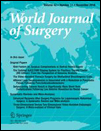Do Nano-crystalline Silver-Coated Hernia Grafts Reduce Infection?
Abstract
Purpose
Inguinal hernia repairs are the most common interventions in adults in general surgery clinics. Depending on the type of mesh and repair, the incidence of mesh-related infection ranges from 0.6 to 8%. Methicillin-resistant Staphylococcus aureus is the most common microorganism causing graft infection. The aim of this study was to investigate the efficacy of nano-crystalline silver-coated polypropylene grafts against graft infection created with MRSA in rats.
Methods
A total of 60 female, Wistar albino rats were used in the study. Polypropylene grafts 1 × 1 cm in size were coated in silver ion-doped, calcium phosphate-based, antibacterial ceramic powder (NS-coated graft) to provide an antimicrobial effect. The MRSA seeding procedure was applied at the same time as surgery. In Group 1, normal graft was applied without MRSA seeding, in Group 2, normal graft with MRSA seeding, in Group 3, NS-coated graft without MRSA seeding, and in Group 4, NS-coated graft with MRSA seeding. For the groups which were to be infected, the bacteria were seeded in the surgical area during the operation. On the 7th day postoperatively, all the animals were killed. The grafts were removed and one from each group was examined under electron microscope and the others were implanted in culture medium and the number of colonies was counted after 24 h.
Results
In Groups 1 and 3, the incision site was seen to have healed on day 3, no clinical surgical area infection was seen during follow-up, and in the exploration made on the 7th day, no findings of infection were observed. In Group 2, hyperemia and collection were seen to have formed on day 3, abscess had started to form in all the rats of this group on day 4, a purulent discharge in the wound site had started in 12 animals on day 5, separation of the wound site was observed in 6 on day 6, and in the exploration on day 7, there was seen to be a fibrin and pus-rich collection around the graft in all cases. In Group 4, there were hyperemia and collection in 6 animals on day 4, and in 3 of these, abscess was seen to have formed on the 5th day. No purulent discharge or wound separation was observed. In the exploration on the 7th day, it was seen that in the animals with abscess development, the formation was of a localized abscess. The results of the cultures of the grafts removed from Groups 1 and 3 showed no production, whereas production was seen in all the grafts removed from Groups 2 and 4. Clinical surgical area infection was seen to have developed in 100% of Group 2 and in 40% of Group 4. In the comparison of the number of colonies, a statistically significantly lower number of bacteria were determined in Group 4 compared to Group 2 (p < 0.05). In the SEM images taken of Group 2, bacteria clusters were seen attached to the graft.
Conclusion
Consistent with previous findings in the literature, the NS-coated polypropylene graft was seen to have a significantly better bactericidal effect than the normal polypropylene graft. Development of NS-coated grafts seems to be a reliable and applicable method to reduce the incidence of postoperative graft infection.




